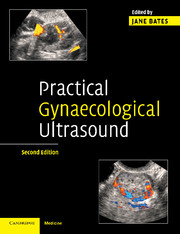Book contents
- Frontmatter
- Contents
- List of contributors
- Preface
- 1 Equipment selection and instrumentation
- 2 Practical equipment operation and technique
- 3 Anatomy, physiology and ultrasound appearances
- 4 Pathology of the uterus, cervix and vagina
- 5 Pathology of the ovaries, fallopian tubes and adnexae
- 6 Ultrasound in the acute pelvis
- 7 Ultrasound and fertility
- 8 Paediatric gynaecological ultrasound
- 9 Clinical management of patients: the gynaecologist's perspective
- Index
- References
8 - Paediatric gynaecological ultrasound
Published online by Cambridge University Press: 04 March 2010
- Frontmatter
- Contents
- List of contributors
- Preface
- 1 Equipment selection and instrumentation
- 2 Practical equipment operation and technique
- 3 Anatomy, physiology and ultrasound appearances
- 4 Pathology of the uterus, cervix and vagina
- 5 Pathology of the ovaries, fallopian tubes and adnexae
- 6 Ultrasound in the acute pelvis
- 7 Ultrasound and fertility
- 8 Paediatric gynaecological ultrasound
- 9 Clinical management of patients: the gynaecologist's perspective
- Index
- References
Summary
Ultrasound is clearly established as the imaging modality of choice for the evaluation of paediatric gynaecological conditions. In certain circumstances magnetic resonance imaging (MRI) will also have a role, as will specialised techniques such as genitography. Computed tomography (CT) has a very limited place and should be avoided, if possible, because of the significant dose of ionising radiation to the ovaries.
Ultrasound technique
Children of all ages have many special needs and all ultrasound examinations should be undertaken by those with experience of managing children who are also aware of the very different pathology likely to be encountered. Particularly for smaller children, a friendly environment is essential with appropriate toys and books to distract especially the preschool child.
As scans must be carried out transabdominally, a full bladder is necessary, which most girls over the age of 3 or 4 years can readily achieve. In younger children and babies it is pure chance as to whether the bladder is full or not. If it is not, then the infant should be given a drink and rescanned at half-hourly intervals until the bladder is full enough for an adequate examination. In neonates the bladder tends to fill and empty even more quickly so the time interval can be shorter.
Modern broadband curvilinear transducers are most appropriate, with a frequency range of 5–8 MHz in the neonate, 4–7 MHz in the older child and 3–5 MHz reserved for adolescents.
- Type
- Chapter
- Information
- Practical Gynaecological Ultrasound , pp. 126 - 141Publisher: Cambridge University PressPrint publication year: 2006



